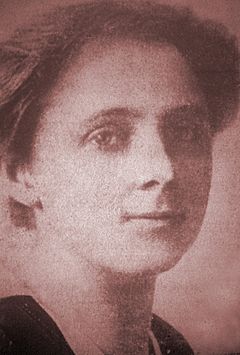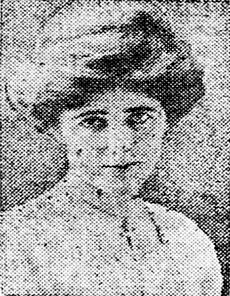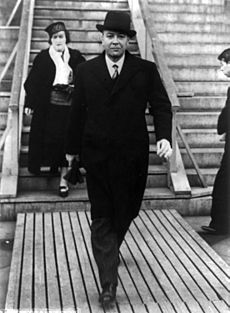Louise Bryant facts for kids
Quick facts for kids
Louise Bryant
|
|
|---|---|

Portrait of Bryant in 1913 by John Henry Trullinger
|
|
| Born |
Anna Louise Mohan
December 5, 1885 San Francisco, California, U.S.
|
| Died | January 6, 1936 (aged 50) Sèvres, France
|
| Resting place | Cimetière des Gonards |
| Alma mater | University of Oregon |
| Occupation | Journalist |
| Spouse(s) | Paul Trullinger (1909–1916; divorce) John Reed (1916–1920; his death) William Christian Bullitt, Jr. (1924–1930; divorce) |
| Children | Anne Moen Bullitt (1924–2007) |
Louise Bryant (born December 5, 1885 – died January 6, 1936) was an American journalist and activist. She is best known for her reports on Russia and the Bolsheviks during the Russian Revolution in November 1917.
Born Anna Louise Mohan, she later used her stepfather's last name, Bryant. She grew up in rural Nevada and studied at the University of Nevada and the University of Oregon. She earned a degree in history in 1909.
After college, she became a journalist in Portland, Oregon. She wrote for the Spectator and The Oregonian. During her time in Portland (1909–1915), she became active in the women's suffrage movement. This movement worked to gain voting rights for women.
In 1915, she moved to Greenwich Village in New York City to be with fellow journalist John Reed. They married in 1916. In New York, she became friends with important feminists. She also worked with the Provincetown Players, a theater group. In 1919, she was arrested during a women's rights rally in Washington, D.C., and spent three days in jail.
In 1917, Bryant reported on the Russian Revolution. She wrote about Russian leaders like Katherine Breshkovsky, Maria Spiridonova, Alexander Kerensky, Vladimir Lenin, and Leon Trotsky. Her news stories were published in newspapers across the United States and Canada.
A collection of her articles from her first trip to Russia was published in 1918 as Six Red Months in Russia. She later spoke to a Senate committee to defend the revolution. In 1919, she went on a speaking tour across the country. She encouraged public support for the Bolsheviks and spoke against U.S. military involvement in Russia.
After John Reed died in 1920, Bryant continued to write for Hearst newspapers. She reported from Russia, Turkey, Hungary, Greece, Italy, and other countries. Some of her articles from this time were put into a book called Mirrors of Moscow in 1923.
Later in 1923, she married William C. Bullitt, Jr.. They had a daughter, Anne, in 1924. In her later years, Bryant suffered from a painful illness. She did not write much in her last decade. Bullitt divorced Bryant in 1930. Louise Bryant died in Paris in 1936 and was buried in Versailles. In 1998, her grave was restored by a group from Portland.
Contents
Early Life and Education
Anna Louise Mohan was born in 1885 in San Francisco, California. Her father, Hugh Mohan, was a journalist and speaker who cared about workers' rights. He married Louisa Flick in 1880. They had two children before Anna Louise was born.
In 1885, the family moved to Reno. Her father left the family and never returned. Louise's mother divorced him in 1889 and married Sheridan Bryant, a railway conductor. Louise began using her stepfather's last name, Bryant.
Louise attended high school in Wadsworth and Reno. She went to college at Nevada State University (now the University of Nevada, Reno). She was interested in journalism, debate, art, and sports like basketball. She wrote for school publications.
After her step-grandfather died in 1906, Bryant left school for a short time. She worked as a teacher for children, mostly young Mexicans, at a cattle ranch in Jolon, California. That summer, she moved to Eugene, Oregon, where her brother lived.
She then enrolled at the University of Oregon. She was popular at the school and helped start a sorority. She wrote poems and drew for the Oregon Monthly magazine. She was known for being bold and independent. She graduated in 1909 with a bachelor's degree in history. Her senior project was about the Modoc Indian Wars.
Life in Portland
In the spring of 1909, Bryant moved to Portland, Oregon. She worked as a freelance reporter for The Oregonian and became a society editor for the Portland Spectator. She made friends with people interested in journalism and art.
In late 1909, she met and married Paul Trullinger, a dentist. Bryant kept her maiden name and her own apartment after marriage. She wanted to advance in her career.
She became interested in politics and the women's suffrage movement. Her friend Sara Bard Field encouraged her. Bryant joined the Oregon branch of the College Equal Suffrage League in 1912. She and Field gave speeches for women's voting rights in smaller Oregon cities. Bryant also rode on the suffrage float in Portland's annual Flag Day parade. Women in Oregon gained the right to vote later that year.
Bryant learned about the socialist magazine The Masses through lawyer C. E. S. Wood. She was excited by its articles, especially those by John Reed. She began helping people subscribe to the magazine.
In 1914, John Reed, a well-known writer from Greenwich Village, visited Portland. Bryant and Reed met and fell in love. Reed returned to New York in December 1915. Bryant followed him three days later, leaving her marriage. Trullinger divorced her in July 1916.
Greenwich Village and Cape Cod
In Greenwich Village, Bryant and Reed lived together. Many of Reed's friends were writers, artists, or political activists. They lived a Bohemian lifestyle, which meant they often rejected traditional rules.
Bryant joined Heterodoxy, a women's group that included feminists like Charlotte Perkins Gilman and Crystal Eastman. She also became friends with other important feminists.
Bryant and Reed worked on their journalism in separate rooms. Reed had reported on important events like the 1913 Paterson silk strike and Pancho Villa.
Later that spring, Bryant and Reed spent the summer in Provincetown, Massachusetts, at the tip of Cape Cod. They joined the Provincetown Players, a theater group. In 1916, the group performed Bryant's play, The Game.
Life in Croton-on-Hudson
After their summer in Cape Cod, Bryant and Reed returned to Greenwich Village. They also spent weekends in Croton-on-Hudson, where many of their friends had cottages. In October 1916, they bought their own place there.
Reed had kidney problems and needed surgery. To protect Bryant, he wanted to make her his legal heir. They married on November 9, 1916, before Reed went for surgery.
After Reed returned from the hospital, they stayed in Croton-on-Hudson to recover and write. They had planned to travel to China, but these plans changed when the U.S. was likely to enter World War I. The U.S. entered the war on April 6, 1917.
Reed's strong anti-war views made it hard for him to find work. This caused financial stress. Bryant wanted to go to Europe to report on the war. Reed helped her get a press pass, and she sailed in June 1917 to cover the war in France.
In Paris, Bryant tried to get permission to visit the Western Front, but she could not. She gathered information from people in Paris and sent her stories to Reed, who edited them.
Reporting from Petrograd
In mid-August, Bryant returned from France. Reed met her and told her to prepare to go to Petrograd (then the capital of Russia) to cover the Russian Revolution. They arrived about six months after the last Russian czar, Nicholas II, had been forced to step down.
Bryant and Reed attended meetings and interviewed many important political figures. These included Lenin, Trotsky, and Alexander Kerensky. Both Bryant and Reed later wrote books based on their articles. Bryant's book was Six Red Months in Russia.
Bryant reported widely, covering meetings and interviewing women revolutionaries. Among them were Katherine Breshkovsky, called the "grandmother of the revolution," and Maria Spiridonova. She also interviewed Aleksandra Kollontai, who became the only woman in the Bolshevik government. Bryant gained confidence in her reporting skills during this time. Her work was read across North America.
Life in New York
Bryant returned to New York in February 1918, before Reed. She found Greenwich Village changed by the war. She wrote articles about the October Revolution and gave speeches supporting the new Russian government.
Reed was trying to get home but was delayed. When he arrived in New York in April, all his papers were taken by the government. Without his notes, Reed gave speeches instead, asking the U.S. to recognize the new Russian government. That summer, the couple went back to Croton-on-Hudson.
In September, Bryant and Reed rented a small house in Greenwich Village. Reed was arrested for speaking out against the use of Allied troops in Russia. He was accused of using "disloyal language" about the U.S. military. He was released on bail.
Reed also faced trials for articles and cartoons published in The Masses magazine. He was accused of trying to stop men from joining the army. Bryant was questioned but not charged. Both trials ended without a decision, and the defendants were set free.
In October, Bryant's first book, Six Red Months in Russia, was published. It received good reviews. Reed's book, Ten Days That Shook the World, was published in April 1919.

In February 1919, Bryant went to Washington, D.C., to speak about Russia. She joined a National Woman's Party rally. She was arrested and sentenced to five days in jail for lighting fires on government property. She refused bail and took part in a hunger strike.
After her release, she testified before the Overman Committee, which was investigating Russian activities in the U.S. She tried to convince the committee that Russia had a right to decide its own future. Soon after, she began a cross-country speaking tour called "The Truth About Russia." She spoke to large audiences in many American cities. She was the first woman to defend Lenin and Trotsky at political gatherings across the U.S. Her message was simple: "Hands off Russia!"
After her tour, Bryant and Reed spent time in Croton-on-Hudson, writing and gardening. In late August, Reed went to Moscow to represent the Communist Labor Party of America (CLP). Bryant chose not to join any political party.
The U.S. government soon made the CLP illegal. Reed was in danger of being arrested and could not get a passport to Russia. He left the U.S. secretly in September 1919. During the Palmer Raids and Red Scare, he was accused of trying to overthrow the government. In March 1920, he was arrested in Finland on his way home. Three months later, he was sent back to Moscow in a prisoner exchange. He cabled Bryant, asking her to come if possible.
Reuniting with Reed in Moscow
Bryant traveled without a passport, disguised as a Swedish businesswoman. She arrived in Petrograd in late August 1920. Reed was in Baku for a congress. They finally met in Moscow on September 15. They spent the next few days together, visiting Lenin, Trotsky, and other leaders. Bryant began sending news stories from Moscow to the International News Service.
Reed's Death
A week after Reed returned from Baku, he became ill with dizziness and headaches. Doctors diagnosed typhus, a serious illness. He was sent to the hospital. Louise Bryant was by his side when he died on October 17, 1920, just before his 33rd birthday.
At Reed's funeral, Bryant walked alone behind the hearse. She collapsed during the burial from a heart attack. She woke up in her hotel room, with friends like Emma Goldman and Alexander Berkman nearby.
Further Reporting and Later Life
After Reed's death, Bryant received permission from Lenin to travel to the southern Russian border and nearby countries. She traveled by train through areas affected by famine, interviewing people and taking notes.
She returned to the U.S. in mid-1921. She met William Christian Bullitt, Jr., who worked at Paramount Pictures. She tried to convince him to make Reed's book, Ten Days That Shook the World, into a film. Bullitt was a wealthy Yale graduate who had worked as a journalist and diplomat. He admired John Reed. Although the film project did not happen, Bullitt was charmed by Bryant.
In August, the New York American newspaper began publishing a series of Bryant's articles. She described the famine in Russia, Lenin's new economic policies, and the end of the Russian Civil War. Her tone in these articles was more serious than her earlier reports.
She also arranged with King Features Syndicate to return to Russia to write about Russian people. Her second book, Mirrors of Moscow, was published in 1923. Bryant traveled to Moscow, Berlin, London, Paris, and other cities. In late 1922, she was in Rome with Bullitt. She wrote about Benito Mussolini, the Fascist leader who had just come to power.
Leaving Rome, Bryant covered the Turkish War of Independence. She lived with Bullitt in Constantinople in early 1923. While Bullitt worked on a novel, she reported on the rise of Mustafa Kemal Atatürk, the first president of Turkey. She also interviewed the deposed king of Greece, Constantine I, and his son, George II. Soon after, Bryant stopped her journalism career to focus on her family.
Life in Paris
Later in 1923, Bryant and Bullitt moved to Paris. They married in December. Two months later, Bryant gave birth to her only child, Anne Moen Bullitt (1924–2007). In 1925, they also welcomed an 8-year-old boy, Refik Ismaili Bey, whom they had met in Turkey.
As the wife of a wealthy man, Bryant had duties managing a large household. She told a visitor that she felt her new life was "useless." The marriage between Bryant and Bullitt began to have problems.
Although Bryant continued to write, little of her work was published near the end of her life. Her last published journalism piece, "A Turkish Divorce," appeared in The Nation in August 1925.
By 1926, Bryant was suffering from a painful and incurable illness. Bullitt divorced Bryant in 1930. Bryant remained in Paris. She occasionally advised writer Claude McKay and helped researchers preserve John Reed's papers.
Death and Legacy
Louise Bryant died on January 6, 1936, from a brain hemorrhage in Sèvres, near Paris. She is buried in Cimetière des Gonards in Versailles. In 1998, volunteers from the Oregon Cultural Heritage Commission found her grave. It was crumbling and scheduled for removal. Through their efforts and donations, the grave was restored.
The story of Bryant and Reed is told in the 1981 film Reds. Diane Keaton played Louise Bryant, and Warren Beatty played John Reed.
Images for kids
-
Katherine Breshkovsky, "grandmother of the revolution", was among the women Bryant interviewed in 1917.
-
Anna Louise Strong in 1918, the year before she arranged Bryant's national speaking tour, "The Truth About Russia".
See also
 In Spanish: Louise Bryant para niños
In Spanish: Louise Bryant para niños














